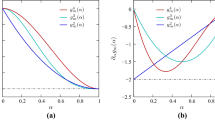Abstract
A theoretical fracture mechanics for brittle piezoelectric and dielectric materials is developed consistent with standard features of elasticity and dielectricity. The influence of electric field and mechanical loading is considered in this approach and a Griffith style energy balance is used to establish the relevant energy release rates. Results are given for a finite crack in an infinite isotropic dielectric and for steady state cracking in a piezoelectric strip. In the latter problem, the effect of charge separation in the material and discharge in the crack are considered. Observations of crack behavior in piezoelectrics under combined mechanical and electrical load are discussed to assess which features of the theory are useful.
Similar content being viewed by others
References
Budiansky, B., Hutchinson, J.W. and Evans, A.G. (1986). M atrix fracture in fiber-reinforced ceramics, Journal of the Mechanics and Physics of Solids 34, 167-189.
Cao, H.C. and Evans, A.G. (1994). Electric-field-induced fatigue crack growth in piezoelectrics, Journal of the American Ceramic Society 77, 1783-1786.
Cherepanov, G.P. (1979). Mechanics of Brittle Fracture, McGraw-Hill, New York p.98.
Deeg, W.F.J. (1980). The Analysis of Dislocation, Crack and Inclusion Problems in Piezoelectric Solids, Ph.D. Thesis, Stanford University.
Dugdale, D.S. (1960). Yielding of steel sheets containing slits, Journal of the Mechanics and Physics of Solids 8, 100-104.
Dunn, M.L. (1994). Electroelastic Green's functions for transversely isotropic piezoelectric media and their application to the solution of inclusion and inhomogeneity problems, International Journal of Engineering Science 32, 119-131.
Eringen, A.C. and Maugin, G.A. (1990). Electrodynamics of Continua I: Foundations and Solid Media, Springer.
Eshelby, J.D. (1957). The determination of the elastic field of an ellipsoidal inclusion, and related problems, Proceedings of the Royal Society of London A241, 376-396.
Fulton, C.C. and Gao, H. (1997). Electrical nonlinearity in fracture of piezoelectric ceramics, Applied Mechanics Reviews 50, 1-8.
Gao, H. and Barnett, D.M. (1996). An invariance property of local energy release rate in a strip saturation model of piezoelectric fracture, International Journal of Fracture 79, R25-R29.
Gao, H., Zhang, T.-Y. and Tong, P. (1997). Local and global energy release rates for an electrically yielded crack in a piezoelectric ceramic, Journal of the Mechanics and Physics of Solids 45, 491-510.
Griffith, A.A. (1920). The phenomena of rupture and flow in solids, Philosophical Transactions of the Royal Society of London A221, 163-197.
Jaffe, B., Cook W.R. and Jaffe, H. (1971). Piezoelectric Ceramics, Academic Press, London and New York.
Kim, K.-S., McMeeking, R.M. and Johnson, K.L. (1998). Adhesion, slip, cohesive zones and energy fluxes for elastic spheres in contact, Journal of the Mechanics and Physics of Solids 46, 243-266.
Landau, L.D. and Lifshitz, E.M. (1960). Electrodynamic of Continuous Media, Pergamon Press, Oxford.
Lynch, C.S., Yang, W., Collier, L., Suo, Z. and McMeeking, R.M. (1995). Electric field induced cracking in ferroelectric ceramics, Ferroelectrics 166, 11-30.
Marshall, D.B., Cox, B.N. and Evans, A.G. (1985). The mechanics of matrix cracking in brittle-matrix fiber composites, Acta Metallurgica 33, 2013.
McClintock, F.A. and Argon, A.S. (1966). Mechanical Behavior of Materials, Addison-Wesley, Reading, Massachussettes.
McHenry K.D. and Koepke, B.G. (1983). Electric field effects on subcritical crack growth in PZT, Fracture Mechanics of Ceramics 5, 337-352.
McMeeking, R.M. (1989). Electrostrictive stresses near crack like flaws, Journal of Applied Mathematics and Physics (ZAMP) 40, 615-627.
McMeeking R.M. and Hwang, S.C. (1997). On the potential energy of a piezoelectric inclusion and the criterion for ferroelectric switching, Ferroelectrics 200, p. 151.
Pak, Y.E. (1992). Linear electro-elastic fracture mechanics of piezoelectric materials, International Journal of Fracture 54, 79-100.
Pak, Y.E. and Herrmann, G. (1986). Crack extension force in a dielectric medium, International Journal of Engineering Science 24, 1365-1374.
Pak, Y.E. and Tobin, A. (1993). O n electric field effects in fracture of piezoelectric materials, in Mechanics of Electromagnetic Materials and Structures AMD vol. 161/MD vol. 42, ASME.
Pao, Y.-H. (1978). Electromagnetic forces in deformable continua Mechanics Today 4, 209-303.
Park, S.B. and Sun, C.T. (1995a). Effect of electric field on fracture of piezoelectric ceramics, International Journal of Fracture 70, 203-216.
Park, S.B. and Sun, C.T. (1995b). Fracture criteria for piezoelectric ceramics, Journal of the American Ceramic Society 78, 1475-1480.
Parton, V.Z., (1976). A fracture mechanics of piezoelectric materials, Acta Astronautica 3, 671-683.
Parton V.Z. and Kudryavtsev, B.A. (1988). Electromagnetoelasticity, Gordon and Breach Science Publishers, New York.
Pohanka, R.C. and Smith, P.L. (1988). Electronic Ceramics, Marcel Dekker, New York.
Rice, J.R. (1968). A path independent integral and the approximate analysis of strain concentration by notches and cracks, Journal of Applied Mechanics 35, 379-386.
Schneider, G.A. and Heyer, V. (1999). Influence of the electric field on Vickers indentation crack growth in BaTiO3, Journal of the European Ceramic Society 19, 1299-1306.
Smith, T.E. and Warren, W.E. (1996). Some problems in two-dimensional electrostriction, Journal of Mathematical Physics, 45 45-51; corrigenda 47, 109-110.
Sosa, H.A. (1991). Plane problems in piezoelectric media with defects, International Journal of Solids and Structures 28, 491-505.
Sosa, H.A. (1992). On the fracturemechanics of piezoelectric solids, International Journal of Solids and Structures 29, 2613-2622.
Sosa, H.A. and Pak, Y.E. (1990). Three-dimensional eigenfunction analysis of a crack in a piezoe lectric material, International Journal of Solids and Structures 26, 1-15.
Suo, Z., Kuo, C.-M., Barnett, D.M. and Willis, J.R. (1992). Fracture mechanics for piezoelectric solids, Journal of the Mechanics and Physics of Solids 40, 739-765.
Tada, H., Paris, P.C. and Irwin, G.R. (1985). The Stress Analysis of Cracks Handbook, Paris Productions Inc., St. Louis, MO.
Timoshenko, S.P. and Goodier, J.N. (1970). Theory of Elasticity, 3rd ed., McGraw-Hill, New York p.193.
Tobin, A.G. and Pak, Y.E. (1993). Effect of electric fields on fracture behavior of PZT ceramics, in SmartMaterials (Edited by V.K. Vardan) Proc. SPIE 1916, 76-86.
Author information
Authors and Affiliations
Rights and permissions
About this article
Cite this article
McMeeking, R.M. Towards a fracture mechanics for brittle piezoelectric and dielectric materials. International Journal of Fracture 108, 25–41 (2001). https://doi.org/10.1023/A:1007652001977
Issue Date:
DOI: https://doi.org/10.1023/A:1007652001977



